As I write this I’m comfortably ensconced in the living room of friends in San Jose, California, jetlagged but conscious. This is after a Day 346 in which I packed up in Tokyo and then visited a museum and an electronics megastore, had more conveyor belt sushi, took the train to the airport, flew overnight from Tokyo to Vancouver, crossed the International Date Line, had coffee with Rob H and Steven G in the Vancouver airport, flew from Vancouver to San Francisco, got picked up and driven to San Jose, napped, and went out for dinner before collapsing into bed at 10:00pm after the longest Wednesday of my life. I’ve got a few days here in the San Francisco area, then it’s home to Winnipeg on Day 351. So the Fat Lady is certainly warming up in the wings, but it ain’t over yet.
There’s still a lot to say about Japan. For instance, I haven’t really talked about the language at all. I found it a much easier to pick up than any of the other Asian languages, mostly because it doesn’t have those maddening tones that make proper pronunciation so difficult. The script, on the other hand, actually employs three different systems all mushed together. Kanji are the borrowed Chinese ideographs that represent whole words or concepts; it’s generally agreed you need to know about 2,000 of these to be considered literate. Hirigana are symbols that are building blocks to forming larger words; they’re complete syllables like ka, sha, ti, tsu, cha, and so on. There are 46 of those. And then there’s katakana, which represent the same syllables as hirigana, but are used for words borrowed from other languages, mostly English. If my name were to be rendered in Japanese it would be done using katakana and would come out something like Pa-me-ra: パ メ ラ. I think this is why the Japanese have such trouble with R and L. There is no L sound in Japanese so R is used as a substitute when they adopt words from other languages that use the L sound. So naturally they have trouble pronouncing L sounds to begin with, and they have trouble remembering when to use R and when to use L when speaking in English). Some excellent Japanified words that would use katakana are things like: “wa-ru-do kap-pu” and “to-ra-be-raz chek-ku”. See if you can figure out what those are.*
And did I mention that there is always a free, clean public toilet around when you need one? Like the vending machines, just when the urge swims into your consciousness, you look up and there they are. And you know how I’ve complained a few times about countries where no one can ever give you change for a large bill? In Japan, vending machines will all take ¥100 notes (that’s a $10 bill) and the local 7-11 won’t bat an eye if you give them a ¥1,000 note for a bottle of water.
Speaking of vending machines, how about some fun vending machine food? I never found any really weird stuff in vending machines, though you can get hot cans in coffee and tea in many. And I did run into these things in a machine in Kyoto, and subsequently saw them in convenience stores too. I couldn’t help but think of soylent green when I saw the package, but it turned out just to be dull and dry chocolately flavoured cookie sticks.
How about a weird drink to wash down your “balanced food block”? Believe me, you’ll need it. Well you could do worse than a refreshing bottle of squid juice! Actually it’s hard to imagine a worse concoction than squid juice, but luckily this turned out to be surprisingly tame.
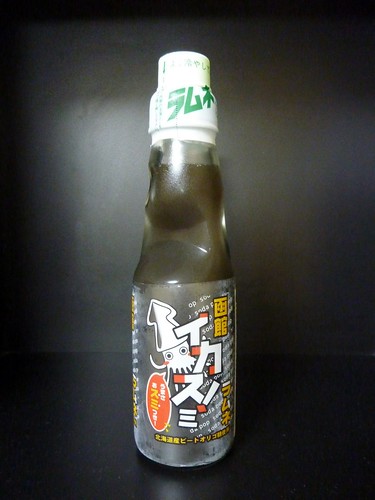 Nicely chilled and ready to drink!
Nicely chilled and ready to drink!
The most interesting thing turned out to be the bottle. It was sealed with a glass ball stuck in the top of the neck. To open the bottle you pull off the plastic cap and peel it apart to turn it into a sort of plunger. Then you put the plunger on top of the ball and smack it with your hand. This forces the glass ball down into the wide part of the neck of the bottle and lets the beverage flow around it. Apparently it’s very retro. And what does carbonated squid juice taste like? Cream soda. No, really. I think the squid ink was only used for colouring because it really just tasted like cream soda. Phew. Talk about dodging a bullet.
And I have to show you this short video I took on my first night in Tokyo, as I was wandering through the Akihabara area. It's... well, it's kind of a car vending machine:
Now, back to some sightseeing. I mentioned in the last post that I’d hoped to get out to the Hakone area, and I actually managed to do that on my last day in Japan when it finally stopped raining. Hakone turned out to be a bit of a bust, but that wasn’t due to the scenery, it was simply because I was trying to fit two days worth of sightseeing into about six hours. First I made my way by bullet train to the city of Odawara. There’s a castle there, and since I hadn’t seen any Japanese castles yet I figured it was worth a stop. It was, but only barely. The original castle dates back to the 15th century, but was demolished in 1872 by order of the Meiji government. The current castle was rebuilt in 1960 and though it’s pretty on the outside the inside is fairly modern looking and filled with case after case of only mildly diverting artifacts. At least they had the decency to build it a short walk from the train station.
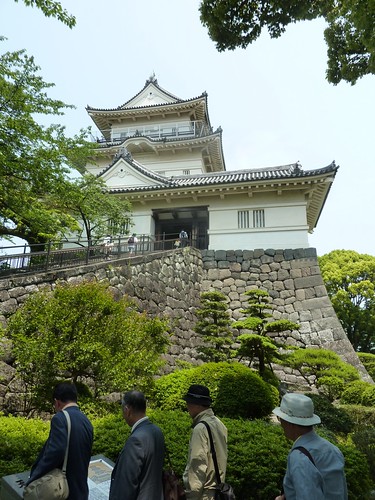 The donjon (keep) of Odawara Castle
The donjon (keep) of Odawara Castle
After hopping onto a slow local train in Odawara, I made it to Hakone-Yumoto, where the wacky transport starts. First is the switchback train, an antique two carriage affair that chugs up the side of a mountain using three switchbacks with a maximum grade of about 8%. They're a bit startling at first, those switchbacks, because the train pulls into a station and then pulls right out again back in the direction it just arrived from. Of course it switches to another track as it’s leaving, but it’s still disconcerting the first few times it happens.
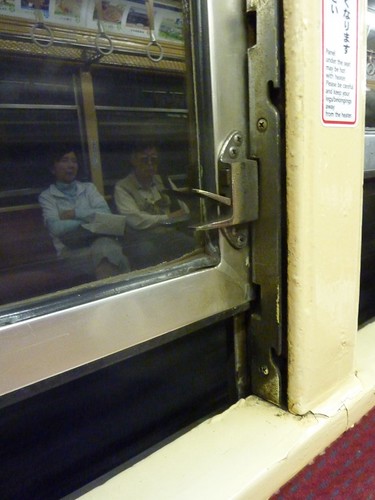 Insufferably arty shot taken on the switchback train
Insufferably arty shot taken on the switchback train
After 45 minutes the train drops you off at the base of the funicular line, which climbs up Mount Soun-zan and deposits you at the cable car station. The cable car then travels over a remarkably blighted valley that looks like a strip-mining operation but is actually a sort of geologically unstable area over a volcanic rift.
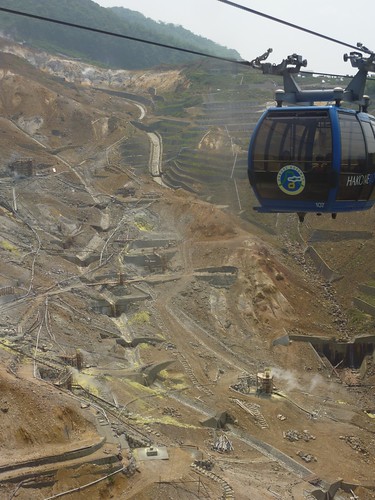 A look at the rift, including the operations that are attempting to stop the mountain from continuing to slide away
A look at the rift, including the operations that are attempting to stop the mountain from continuing to slide away
The volcano is called Owakudani, and at the top there’s a short but smelly walk to view the sulfurous steam bubbling out of milky white pools of water. After Owakaduni it’s possible to take another cable car to the top of Togendai and then visit Ashino-ko Lake where they have tourist boats that are purported to look like something out of “Pirates of the Caribbean”. Unfortunately my schedule meant that I only had time for a quick hike around the windy, stinky slopes of Owakaduni before I had to start retracing my steps back all the way back to Tokyo. I did, however, find the time to indulge in the volcano’s famous weird food: black eggs! These are plain eggs that are boiled in the sulphurous water of the volcano, which causes a checmical reaction that turns the egg’s shell totally black. The legend is that consuming one will add seven years to your life. They’re sold in packs of five (35 years) for ¥500, and EVERYONE tries them while they’re at the top. So many hard boiled eggs have been consumed in the area that in places it looked like the ground was paved in tiny shards of broken eggshell.
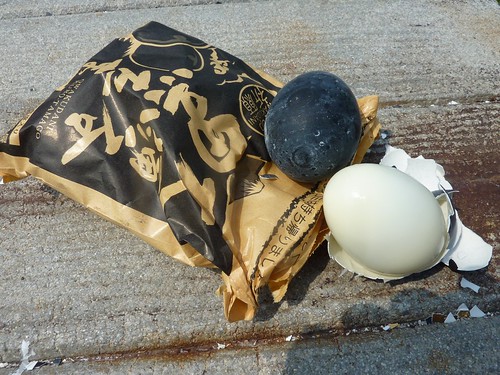 Black on the outside, but plain old white on the inside. They tasted like… boiled eggs. The taste could not hold a candle to the eggs-on-a-stick.
Black on the outside, but plain old white on the inside. They tasted like… boiled eggs. The taste could not hold a candle to the eggs-on-a-stick.
I had to rush back to Tokyo because that evening I was having dinner with Paul and Takako, the dynamic duo who smoothed the way for me the whole time I was in Japan. For their grand finale they invited me over for supper and whipped up a Japanese feast of roll-your-own sushi cones and takoyaki. Takoyaki (literally meaning fried or baked octopus) is a party food that I first saw at the food fair on the temple grounds during Aoi Matsuri in Kyoto, though I didn’t know what it was at the time. And what is/are takoykai? They’re bite-sized fried dumpling sort of things with a chunk of octopus in them, and with tempura bits, pickled ginger, and green onion. At fairs the vendors make them in huge cast-iron grills, but at home people have special little electric tabletop versions. They’re yummy, and get topped with mayonnaise, okonomiyaki sauce, flakes of nori (seaweed) and katsuobushi, which are micro-thin shavings of dried fish that wave like a living thing when the heat from the takoyaki rises past them. It’s fun and tasty.
 Paul and Takako, tending to the tokoyaki, with partially devoured plate of assorted raw fish in the bottom right. (My new favourite is hotate – raw scallops. They are soooo yummy.)
Paul and Takako, tending to the tokoyaki, with partially devoured plate of assorted raw fish in the bottom right. (My new favourite is hotate – raw scallops. They are soooo yummy.)
And after dinner Paul gave me a ride back to my hotel on the back of his motorcycle. He’d picked me up by the same mode, and I loved having a chance to see Tokyo that way. You get a much better view from a bike than you do from a car. After dinner we took the scenic route through Shibuya crossing, which is lit up like Christmas at night.
More video! This is us pulling up to Shibuya crossing just before the pedestrians start their massed scramble through the intersection.
We also went through a few back streets in Shibuya, and I got to see some of the famous “love hotels”. The entrances are shielded from view so you can’t be seen entering or leaving, and they all had signs outside advertising the “rest” rate (just a few hours) and the “stay” rate (overnight). Paul told me he’d read a statistic that said the average stay in one of these places was 45 minutes. That’s the average, which means half of the people who come must stay for less than that... We also drove past the Tokyo tower, and over into Odaiba for a look at the bizarre Fuji TV headquarters “Death Star” building. It was a great ride, and a perfect way to end my last night in Tokyo.
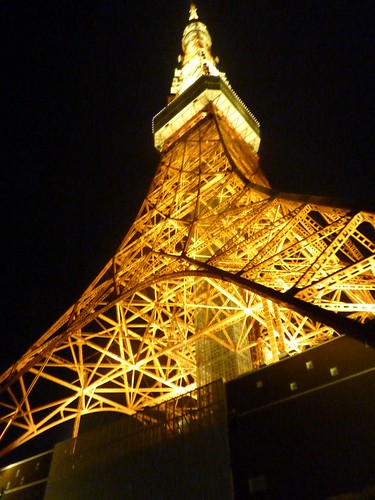 Tokyo Tower. Nine metres taller than the one in Paris on which it was based.
Tokyo Tower. Nine metres taller than the one in Paris on which it was based.
On my last morning in town I finally made it to the tiny Shitimatchi Museum, which was conveniently located next to the train station I needed for the trip to the airport. I stuffed my big bag in a locker at the station (there are always lockers at stations) and went to check it out. It was great – charming and compact, and offering a free English guide service that I took advantage of. The museum is dedicated to showcasing a tiny bit of the Edo period Shitimatchi area, a work-a-day neighbourhood of shops and tenements. The whole main floor was not much bigger than an average Starbucks, and had a recreated tenement house on one side and a recreated shop on the other. The second floor had some fun games and toys you could try and a few interesting displays. My guide was a friendly woman who showed me around for 30 or 40 minutes and when I turned to leave the woman at the front desk stopped me and pulled something out from behind the counter. As she offered it to me she said, “Present”. It turned out to be an amazing bit of origami – an octagonal box with a perfectly-fitting lid that appears to use no fewer than sixteen separate pieces of paper. I have no idea why she gave it to me, but I was blown away. What a great way to end my time in Japan.
Yep, Japan was charming right to the end. For instance, on the train I took out to the airport they switch the orientation of the seats at each end station so that they’re always facing in the direction of travel. That’s nothing special; the shinkansen clean-up crews that descend on the train at terminal stations go through each car and spin the seats by unlocking them with a foot pedal and swinging them around. However the Keisei Skyliner to Narita Airport did this all automatically. I looked over as I was waiting for the train doors to open and saw all the seats in the car spontaneously spin themselves around. I love Japan.
And now I’m in America for continent number 4, country number 33, and bed number 158. In a few days my long journey will be over, but don’t despair. I’ve still got a few things on my mind so you’ll have to endure some more of my long-winded ramblings before we can finally put this thing to bed.
* “Wa-ru-do kap-pu” is World Cup. “To-ra-be-raz chek-ku” are traveler’s cheques. I love that.

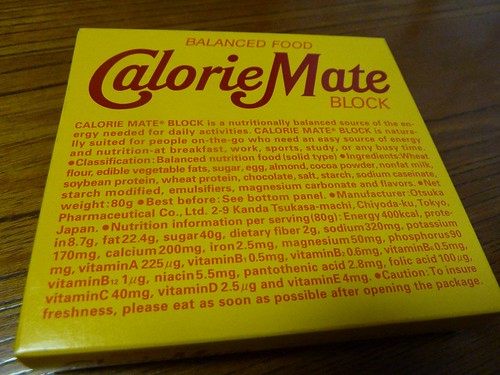
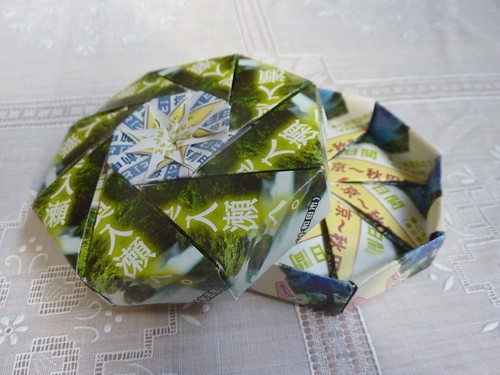


7 Comments:
Actually, I'm going to be kind of sad when this is "put to bed." It's been fun reading your blog for the last several months. You're an excellent writer. Keep rambling as long as you want. :)
Hey Pam I have really enjoyed reading about your travels this last year. I follow many one year travelers and I think you did very well within this last year, even though you had some mishaps occur early on, you delt with those type of situations just fine.
Looking forward to your Winnipeg Home-Coming! And hearing more stories that didn't make it to the blog!...
I LOVE the video from the back of the motorcycle...and at the end we get to see your happy face! YAY!
I am so glad that you got to have the Owakudani black eggs. I was in Hakone on Easter Sunday, and could not rally the troops (my husband) to go in search of those easter eggs. Better luck next time in Hakone! When I was there I thought of you and the weird food.
Cheers!
I love the car-wheel-park !!
I wonder if it stops to get your car off, or if you need to be super speedy on the pedal!
BR
Pam, after following you all year (your bookmark was even in my bookmark bar....not the menu, but the bar!) I'm looking forward to your summation of the trip.
I traveled vicariously with you via your blog, as I'm sure many others did as well.
Your descriptions of the heat in Southeast Asia were enough to make me want to bust out my air conditioner.
Truly the trip of a lifetime!
Cheers, Blair
Post a Comment